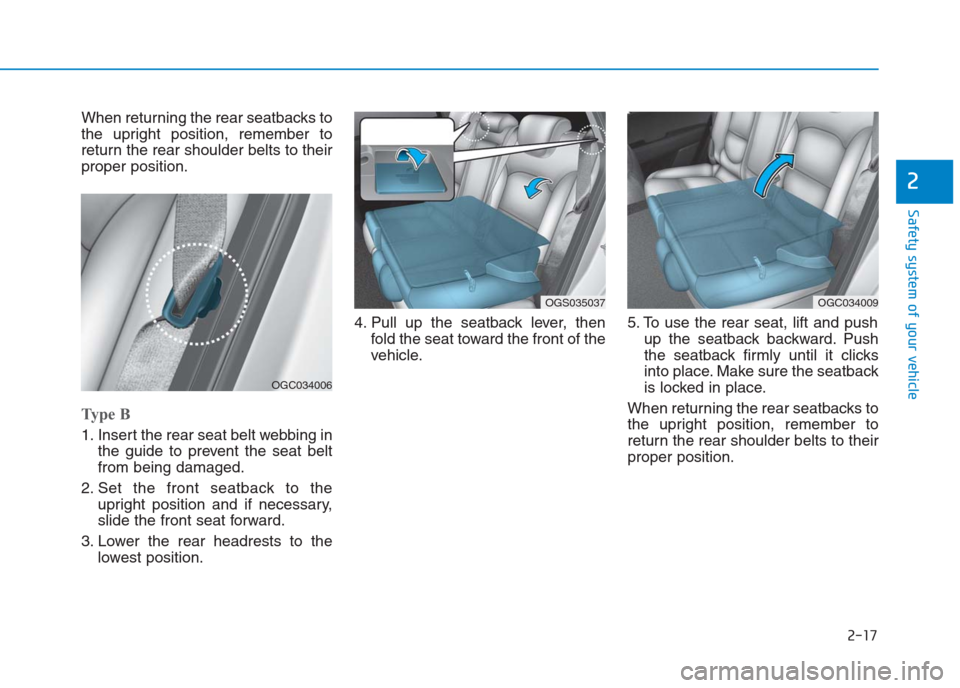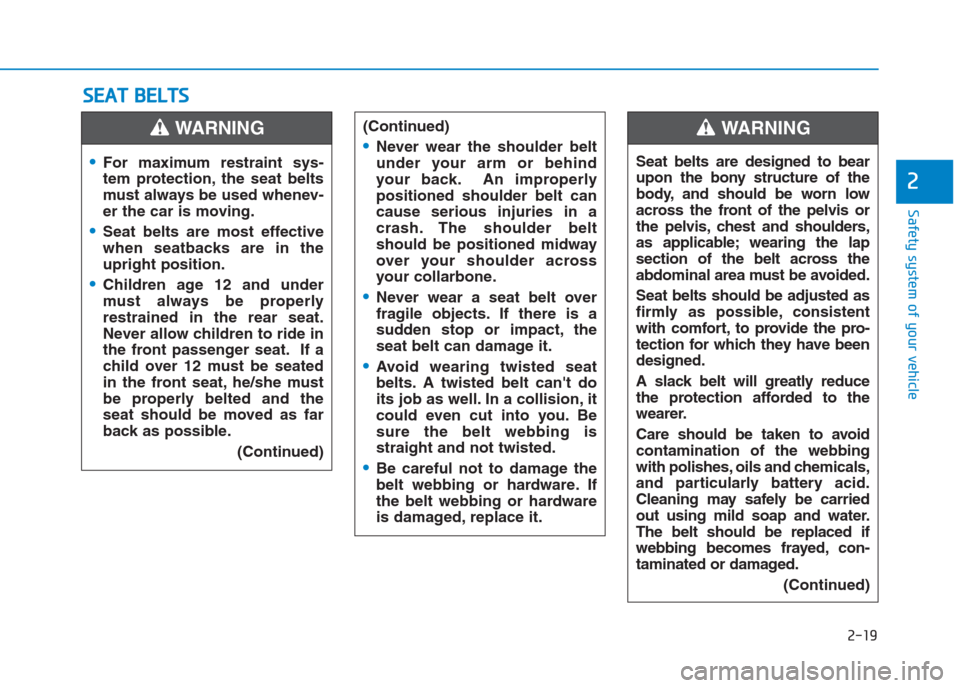2018 Hyundai Creta belt
[x] Cancel search: beltPage 21 of 472

Safety system of your vehicle
2
Safety system of your vehicle
2
Seats .......................................................................2-2
Front seats .......................................................................2-7
Rear seats ........................................................................2-14
Seat belts ..............................................................2-19
Pre-tensioner seat belt ................................................2-25
Additional seat belt safety precautions ...................2-27
Care of seat belts ...........................................................2-30
Child restraint system .........................................2-31
Children always in the rear .........................................2-31
Installing a Child Restraint System (CRS)..................2-33
Air bag-supplemental restraint system(SRS) ..2-43
How does the air bag system operate .....................2-45
Do not install a child restraint on the
front passenger's seat...................................................2-47
Air bag warning and indicator .....................................2-48
SRS components and functions ..................................2-48
Driver's and passenger's front air bag ....................2-52
Side impact air bag ........................................................2-55
Curtain air bag ................................................................2-56
SRS Care ............................................................................2-63
Air bag warning label ....................................................2-65
Page 24 of 472

2-4
Safety system of your vehicle
Loose objects
Loose objects in the driver’s
foot area could interfere with
the operation of the foot pedals,
possibly causing an accident.
Do not place anything under the
front seats.
WARNING
Uprighting seat
When you return the seatback
to its upright position, hold the
seatback and return it slowly
and be sure there are no other
occupants around the seat. If
the seatback is returned with-
out being held and controlled,
the back of the seat could move
forward or backward resulting
in accidental injury to a person
struck by the seatback.
WARNING
Driver responsibility for passen-
gers
Riding in a vehicle with seatback
reclined could lead to serious or
fatal injury in an accident. If a
seat is reclined during an acci-
dent, the occupant’s hips may
slide under the lap portion of the
seat belt applying great force to
the unprotected abdomen. The
protection of your restraint sys-
tem (seat belt and air bags) is
greatly reduced by reclining your
seat. Serious or fatal internal
injuries could result. The driver
must advise the passenger to
keep the seatback in an upright
position whenever the vehicle is
in motion.
WARNING
Do not use a sitting cushion
that reduces friction between
the seat and passenger. The
passenger's hips may slide
under the lap portion of the seat
belt during an accident or a
sudden stop. Serious or fatal
internal injuries could result
because the seat belt can't
operate normally.
WARNING
Page 25 of 472

2-5
Safety system of your vehicle
2
Driver’s seat
Never attempt to adjust seat
while the vehicle is moving.
This could result in loss of
control, and an accident caus-
ing death, serious injury, or
property damage.
Do not allow anything to inter-
fere with the normal position
of the seatback. Storing items
against a seatback or in any
other way interfering with
proper locking of a seatback
could result in serious or fatal
injury in a sudden stop or col-
lision.
Always drive and ride with
your seatback upright and the
lap portion of the seat belt
snug and low across the hips.
This is the best position to pro-
tect you in case of an accident.
(Continued)
WARNING (Continued)
In order to avoid unnecessary
and perhaps severe air bag
injuries, always sit as far back
as possible from the steering
wheel while maintaining com-
fortable control of the vehicle.Rear seatbacks
The rear seatback must be
securely latched. If not, passen-
gers and objects could be
thrown forward resulting in seri-
ous injury or death in the event
of a sudden stop or collision.
Luggage and other cargo
should be laid flat in the cargo
area. If objects are large, heavy,
or must be piled, they must be
secured. Under no circum-
stances should cargo be piled
higher than the seatbacks.
Failure to follow these warnings
could result in serious injury or
death in the event of a sudden
stop, collision or rollover.
No passenger should ride in the
cargo area or sit or lie on folded
seatbacks while the vehicle is
moving. All passengers must be
properly seated in seats and
restrained properly while riding.
(Continued)
WARNING
Page 26 of 472

2-6
Safety system of your vehicle
(Continued)
When resetting the seatback to
the upright position, make sure
it is securely latched by push-
ing it forward and backwards.
To avoid the possibility of
burns, do not remove the carpet
in the cargo area. Emission con-
trol devices beneath this floor
generate high temperatures.
After adjusting the seat, always
check that it is securely locked
into place by attempting to
move the seat forward or back-
ward without using the lock
release lever. Sudden or unex-
pected movement of the dri-
ver's seat could cause you to
lose control of the vehicle
resulting in an accident.
WARNING
Do not adjust the seat while
wearing seat belts. Moving the
seat cushion forward may
cause strong pressure on the
abdomen.
Use extreme caution so that
hands or other objects are not
caught in the seat mechanisms
while the seat is moving.
Do not put a cigarette lighter
on the floor or seat. When you
operate the seat, gas may gush
out of the lighter and cause
fire.
If there are occupants in the
rear seats, be careful while
adjusting the front seat posi-
tion.
WARNING
Page 36 of 472

2-16
Safety system of your vehicle
Folding the rear seat
The rear seatbacks (or cushions)
may be folded to facilitate carrying
long items or to increase the luggage
capacity of the vehicle.
Type A
1. Set the front seatback to the
upright position and if necessary,
slide the front seat forward.
2. Insert the rear lap/shoulder belt
plate into the holder on the seat
and side trim. It will prevent the
lap/shoulder belt from interfering
with the seatback when folding.
3. Pull up both sides of the seatback
lever and fold the seatback toward
the front of the vehicle.
To use the rear seat, lift and push up
the seatback backward. Push the
seatback firmly until it clicks into
place. Make sure the seatback is
locked in place.
OGS035031
OGS035013
OGS035014
Never allow passengers to sit
on top of the folded down
seatback while the vehicle is
moving as this is not a proper
seating position and no seat
belts are available for use.
This could result in serious
injury or death in case of an
accident or sudden stop.
Objects carried on the folded
down seatback should not
extend higher than the top of
the front seats. This could
allow cargo to slide forward
and cause injury or damage
during sudden stops.
WARNING
Page 37 of 472

2-17
Safety system of your vehicle
2
When returning the rear seatbacks to
the upright position, remember to
return the rear shoulder belts to their
proper position.
Type B
1. Insert the rear seat belt webbing in
the guide to prevent the seat belt
from being damaged.
2. Set the front seatback to the
upright position and if necessary,
slide the front seat forward.
3. Lower the rear headrests to the
lowest position.4. Pull up the seatback lever, then
fold the seat toward the front of the
vehicle.5. To use the rear seat, lift and push
up the seatback backward. Push
the seatback firmly until it clicks
into place. Make sure the seatback
is locked in place.
When returning the rear seatbacks to
the upright position, remember to
return the rear shoulder belts to their
proper position.
OGC034006
OGS035037OGC034009
Page 38 of 472

2-18
Safety system of your vehicle
When returning the rear seat-
backs to the upright position,
remember to return the rear
shoulder belts to their proper
position.
Routing the seat belt webbing
through the rear seat belt guides
will help keep the seat belts from
being trapped behind or under
the seats.
NOTICE
Cargo
Cargo should always be secured
to prevent it from being thrown
about the vehicle in a collision
and causing injury to the vehicle
occupants. Do not place objects
in the rear seats, since they can-
not be properly secured and may
hit the front seat occupants in a
collision.
WARNING
When you return the rear seat-
back to its upright position after
being folded down:
Be careful not to damage the
seat belt webbing or buckle. Do
not allow the seat belt webbing
or buckle to get caught or
pinched in the rear seat. Ensure
that the seatback is completely
locked into its upright position
by pushing on the top of the
seatback. Otherwise, in an acci-
dent or sudden stop, the seat
could fold down and allow
cargo to enter the passenger
compartment, which could
result in serious injury or death.
WARNING
Cargo loading
Make sure the engine is off, the
manual transaxle is in R
(Reverse) or 1st, and the parking
brake is securely applied when-
ever loading or unloading cargo.
Failure to take these steps may
allow the vehicle to move if the
shift lever is inadvertently moved
to another position.
WARNING
Page 39 of 472

2-19
Safety system of your vehicle
2
S SE
EA
AT
T
B
BE
EL
LT
TS
S
For maximum restraint sys-
tem protection, the seat belts
must always be used whenev-
er the car is moving.
Seat belts are most effective
when seatbacks are in the
upright position.
Children age 12 and under
must always be properly
restrained in the rear seat.
Never allow children to ride in
the front passenger seat. If a
child over 12 must be seated
in the front seat, he/she must
be properly belted and the
seat should be moved as far
back as possible.
(Continued)
WARNING (Continued)
Never wear the shoulder belt
under your arm or behind
your back. An improperly
positioned shoulder belt can
cause serious injuries in a
crash. The shoulder belt
should be positioned midway
over your shoulder across
your collarbone.
Never wear a seat belt over
fragile objects. If there is a
sudden stop or impact, the
seat belt can damage it.
Avoid wearing twisted seat
belts. A twisted belt can't do
its job as well. In a collision, it
could even cut into you. Be
sure the belt webbing is
straight and not twisted.
Be careful not to damage the
belt webbing or hardware. If
the belt webbing or hardware
is damaged, replace it.
Seat belts are designed to bear
upon the bony structure of the
body, and should be worn low
across the front of the pelvis or
the pelvis, chest and shoulders,
as applicable; wearing the lap
section of the belt across the
abdominal area must be avoided.
Seat belts should be adjusted as
firmly as possible, consistent
with comfort, to provide the pro-
tection for which they have been
designed.
A slack belt will greatly reduce
the protection afforded to the
wearer.
Care should be taken to avoid
contamination of the webbing
with polishes, oils and chemicals,
and particularly battery acid.
Cleaning may safely be carried
out using mild soap and water.
The belt should be replaced if
webbing becomes frayed, con-
taminated or damaged.
(Continued)
WARNING